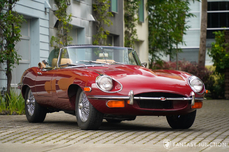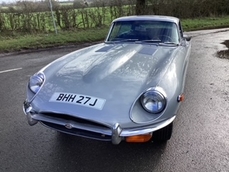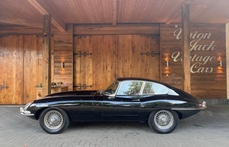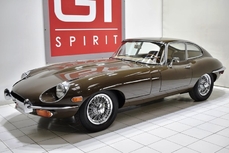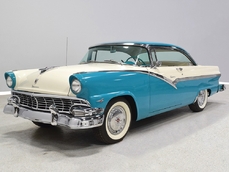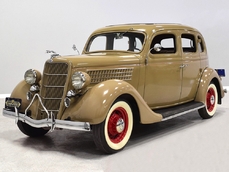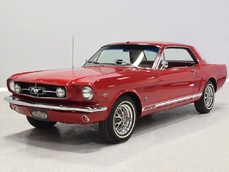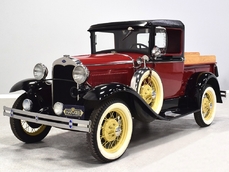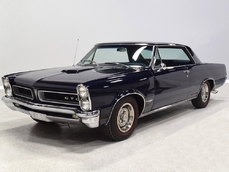Jaguar E-type 4.2 liter DOHC inline-6 1969
Allmän beskrivning :
When discussing the Jaguar XKE, or the E-Type as it was called in its homeland, there are some things that we all assume are a given: it’s gorgeous, it’s expensive, and it’s one of the most delightful cars in the world to drive. Until you’ve driven one, you probably can’t quite grasp the downright joyous way they go about their business, with a remarkably supple ride, the bellowing six-cylinder engine note, and looks that make you want to study it from every angle. Never has a car been so right in so many ways, and the recent rise in E-Type prices finally justifies the passion that owners have held for these cars for so many years. There are few other cars that satisfy the mind, heart, and soul better than an E-Type.
While there’s a definite pecking order in terms of values among E-Type aficionados, if you’re someone who loves the drive a Series II car is what you want to own. More sophisticated, more powerful, and more spacious than the Series I cars, they were the result of all the feedback and upgrades done along the way. The 4.2 liter engine is wonderfully potent, yet tractable and user-friendly. Overheating issues were a thing of the past. The cabin was finally spacious enough for real-sized people. And it lost none of the sinuous grace of the original styling. Many call it a supercar for the masses, but I don’t think that’s quite right because supercars are finicky. I would call the E-Type a daily driver with the charisma and performance of a supercar.
Finished in brilliant Signal Red, this 1969 E-Type Series II has a recent and comprehensive restoration that shows its quality in multiple JCNA show wins. Although BRG is a favorite on Jaguars, if you’re going to attract attention, you may as well do it right with a bright red car—it’s just spectacular in person. It’s vivid and deep, and the shade is just right for a vintage Jag. The restoration was done to the highest standards and it likely fits together better now than when it was new, with even gaps and doors that latch easily without a heavy slam. It appears to be wearing all its original sheetmetal with no patches or replacements, but given the state of the art in Jaguar restorations, metalsmiths making replacement pieces disappear is not surprising. Either way, it is just beautifully done with no asterisks needed. The mirror-finish paint is show-quality with only one or two small signs that it has been driven, and obviously all the weather seals are new. Likewise, all the chrome was refinished to show standards, with only the rear bumper starting to show a few signs of age that likely comes from its proximity to the exhaust. Unavoidable. Lights, signals, lenses, and glass are all unmarked and like new. This is an exceptionally well-restored Jaguar.
The tan Connolly leather interior demonstrates why the Series II cars are so desirable for drivers. The seats are more adjustable than the early shells and far more plush for long trips. There’s more leg room and more room in the foot boxes so you don’t need to be a ballerina to heel-and-toe it. The leather seat covers show some minor comfort marks, and given the quality of the restoration and its relative youth, there’s a possibility that the seats might be original and just very nicely preserved, it’s hard to say. They’re not quite as nice as the rest of the interior, but they remain excellent and replacing them would probably be a mistake. On the other hand, the carpets, door cards, and dashboard are brand new, as is the bulkhead cover behind the seats. A lovely wood-rimmed Moto-Lita steering wheel is original, not a reproduction, and all the Smiths instruments are restored and operational. Big, easy-to-use rockers replaced the delicate toggles of the early cars and this one sports a Jaguar-logo AM/FM/cassette stereo head unit that certainly seems appropriate, although it’s quite modern with digital tuning. A new StayFast tan canvas top folds easily and offers fresh weather seals so it closes up reasonably well, although you should not expect a vintage Jaguar roadster to be water-tight—that just wouldn’t be proper. The trunk is likewise outfitted with a proper set of mats and side panels, as well as a matching chrome wire wheel in the tire well (which, you’ll note, is original and rust-free).
This is the car’s original, numbers-matching 4.2 liter DOHC inline-6. A little more displacement made it a much friendlier car on American roads, and the big six is happy to rumble along in 4th gear at barely more than a walking pace. It was fully rebuilt to stock specs during the restoration and it is properly tuned, unlike so many of its siblings. I remain convinced that Jaguar’s reputation for fussiness and unreliability is unwarranted, with the blame laying squarely on the shoulders of owners unwilling to maintain them to spec. This one, for instance, starts instantly and idles smoothly with a bit of choke. As it warms, push the choke in and it drops to a friendly 800 RPM idle, ready to enjoy. No drama, just turn the key and go. Even when it’s hot, it shows no bad habits, which is surely how it was when it was new and why I would argue that this is a supercar you can drive every day. The engine makes delightful noises and is beautiful to look at, as well. Finned cam covers, polished aluminum, and expert detailing make the underhood area almost too pretty to hide. Twin side-draft carburetors are easier to keep in synch than the earlier triple carb setup, yet give up nothing in the horsepower department. You also get a correct coil and Champion ignition wire set, a proper washer bottle on the firewall, and factory-style fittings and hardware used throughout. Someone clearly knew their Jaguars when this car came together.
The 4-speed manual gearbox is likewise numbers-matching, as is the independent rear end with 3.54 gears inside. The chassis is exquisitely detailed with painted subframes, a polished stainless steel exhaust system with resonators, and a protective textured layer on the floors and other vitals. Obviously everything is new or rebuilt and detailing is exacting, from the type of cotter pins used in the suspension to the splash shields around the soil pan. Jaguar’s wonderfully capable yet strangely supple and comfortable suspension tuning is something no other auto maker has been able to duplicate, and it’s quite evident in the E-Type, which seems to ignore bumps without becoming loose and soft-feeling. How’d they do that? Braking is effective and the sound from the twin pipes out back is worth dropping down a gear or two every time you go through a tunnel—after all, isn’t that part of why you own a Jaguar? Gorgeous chrome wire wheels with correct knock-off hubs glitter against the red paint and wear modern 205/70/15 Goodyear radials.
A Heritage Certificate has been ordered.
We’ve sold a few E-Types in recent months, and this is by far the finest in terms of quality and pedigree. Beautiful in every way that matters, fully functional, and ready to enjoy. You could show it and have some success, but after you slide behind the wheel and let the big cat seduce you, you’ll probably find that driving is what it loves most. Call today!
http://www.harwoodmotors.com/vehicles/inventory_details.php?id=861
1969 Jaguar E-type 4.2 liter DOHC inline-6 is listed såld on ClassicDigest in Macedonia by for $109900.
Fakta i bilen
Karosstyp : Personbil Märke : Jaguar Modell : E-type Modellversion : 4.2 liter DOHC inline-6 Motorvolym : 4.2 Årsmodell : 1969 Karosstyp : Convertible Läge : Ohio
Såld
Information om säljaren
Såld
People who viewed this Jaguar E-type also viewed similar Jaguar listed at ClassicDigest
Other cars listed for sale by this dealer
om Jaguar
Åh, historien om Jaguar, från dess tidiga dagar som SS Cars Ltd. till sin höjdpunkt med D-typen och gatubilsevolutionen i form av den ikoniska E-typen. Det finns något alldeles brittiskt över denna berättelse, och jag ska berätta den som en brittisk journalist skulle göra.
I början:
Vår resa in i Jaguar-världen börjar på 1930-talet, när ett företag som kallades SS Cars Ltd. dök upp. Trots den olyckliga sammanträffandet av deras initialer med de stigande politiska spänningarna i Europa började de producera stilfulla och prestandainriktade bilar. SS 100, som introducerades 1936, var en symbol för elegans och hastighet och lade grunden för vad som skulle bli Jaguar.
Jaguars födelse:
När skuggan av andra världskriget närmade sig beslutade SS Cars Ltd. klokt att distansera sig från SS-initialerna. Så 1945 blev de officiellt Jaguar Cars Ltd., ett namn som snart skulle bli synonymt med brittisk lyx och prestanda.
XK-serien:
Jaguars efterkrigstid gav oss XK 120, en verklig sensation 1948. Med sin strömlinjeformade design och en kraftfull 3,4-liters raksexmoters blev den världens snabbaste seriebil. XK 120 var ritningen för det som komma skulle - Jaguar som förenade stil med hastighet på ett unikt brittiskt sätt.
D-typens dominans:
Sedan kom D-typen, en sann racinglegend. Introducerad 1954, vann den Le Mans tre gånger på 1950-talet och visade Jaguars tekniska skicklighet. Med sin innovativa monokokkonstruktion och den ikoniska fenan bak var D-typen höjdpunkten av Jaguars framgång inom motorsport.
E-typens framträdande:
Men den verkliga vändpunkten kom 1961 med introduktionen av E-typen, ofta beskriven av Enzo Ferrari som "den vackraste bilen som någonsin byggts". Dess långa motorhuv, böljande kaross och en 3,8-liters motor som levererade upphetsande prestanda gjorde den till en omedelbar klassiker. E-typen var inte bara en bil; den var ett konstverk på hjul och kunde nå 150 mph på vägen.
Gata och racingsuccé:
E-typens skönhet matchades av dess förmåga på racerbanan. De lätta E-typarna var särskilt framgångsrika i olika racingevenemang och cementerade Jaguars rykte som en kraft att räkna med inom motorsport.
Raffinemangets ålder:
När vi fördjupar oss i Jaguar-historien finner vi att 1950-talet och 1960-talet var en tid av raffinering och expansion. Tillsammans med den magnifika D-typen och den ikoniska E-typens framträdande introducerade Jaguar modeller som ytterligare befäste sitt rykte för lyx och prestanda.
MK2:
I slutet av 1950-talet presenterade Jaguar MK2, en sportig sedan som kombinerade elegans med kraft. Denna eleganta fyradörrars salong var en favorit bland bankrånare och polisen, tack vare dess exceptionella hastighet och hantering. MK2 var en symbol för Jaguars förmåga att förena sofistikering med prestanda och hade också en framgångsrik racingkarriär.
XJ6:
Hoppa fram till 1968 och Jaguar lanserade en bil som skulle definiera lyxbilar i decennier framöver - XJ6. Det var ett mästerverk i teknik och design med en jämn raksexmoters, oberoende bakre fjädring och en rymlig, vackert inredd interiör. XJ6 var en symbol för brittisk elegans och erbjöd en så smidig åktur att det kändes som om den gled över vägen. Den blev flaggskeppsmodellen för Jaguar och satte standarden för lyxbilar och visade en nivå av raffinering som imponerade på konkurrenterna.
Blandningen av klassiskt och modernt:
Medan MK2 och XJ6 representerade utvecklingen av Jaguars sedanmodeller, bibehöll de märkets engagemang för prestanda och lyx. Dessa bilar hörde inte bara hemma på racerbanan; de trivdes lika bra på de stora boulevarderna som på en avslappnad körning genom den engelska landsbygden.
Utmaningarna av förändring:
Men när 1970-talet närmade sig, ställdes Jaguar, liksom många brittiska biltillverkare, inför ekonomiska utmaningar och ägarförändringar. British Leyland-eran förde både möjligheter och svårigheter med sig när varumärket navigerade genom olika sammanslagningar och övergångar.
Ändå fortsätter arvet från MK2 och XJ6, tillsammans med D-typen och E-typen, att definiera Jaguar som en tillverkare som förenar tidlös elegans med en anda av prestanda. Dessa klassiska modeller, vare sig de körs på slingrande vägar eller står som samlarföremål, tjänar som ett vittnesbörd om Jaguars långvariga närvaro inom den automobila exklens värld.
Jaguar-historien, från dess tidiga dagar som SS Cars Ltd. till skapandet av ikoner som E-typen, MK2 och XJ6, är en resa som speglar essensen av brittisk bilkultur - en blandning av lyx, kraft och stil som fortsätter att fängsla entusiaster och samlare över hela världen.



